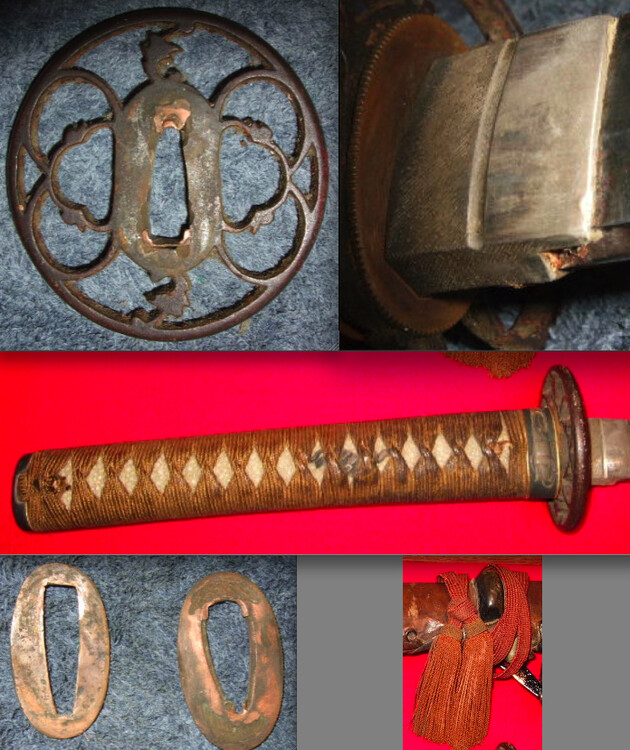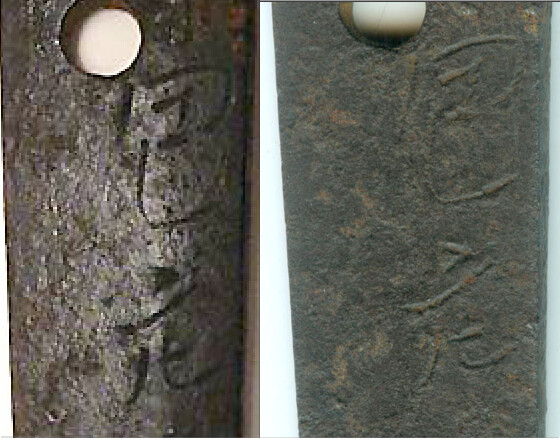-
Posts
779 -
Joined
-
Days Won
1
Content Type
Profiles
Forums
Events
Store
Downloads
Gallery
Everything posted by reinhard
-
Hi Sean, When trying to understand this sword you better separate the blade from its koshirae. This particular koshirae is an occasional assembly of mismatching parts. There are a leather frog and a tassel pointing towards WWII, but the tassel is not where it is supposed to be. Tsuka and tsuba seem to be of earlier date, but at a closer look they are not. The crossings of tsuka-ito are all made in the same direction and the diamond shapes in between look poor. This is pointing towards a later date of manufacture. The habaki is not fitting the blade properly. Seppa are asymmetrical and of poor quality. - All in all you better focus on the blade. The koshirae can be neglected. reinhard
-
Hi Jimi, I'm inclined to believe this sword was retempered. One particular feature pointing towards this direction is the Ha-Hada (Hada clearly visible within the Yakiba). This can be seen often in retempered blades. This could be due to a poor polishing job as well though. This katana was polished by a togishi from a minor league. Hadori finish looks stiff and awkward and lacks refined taste. - Another irritating feature are mekugi-ana. The "older" one (below the "actual" mekugi-ana) looks quite fresh, particularly on the inside. The nakago seems to be shortened in a quite careless manner, judging from nakago-jiri. All in all, it looks like a retempered katana trimmed to look old, but this is just a guess on the basis of pics and we all know what that means. reinhard
-
The mei reads "YOSHIMITSU", but it appears to be a crude fake. No real smith to track, I'm afraid. reinhard BTW, please add your real name to your post. That's the way it is on NMB.
-
Pictures are not very reliable, but hada seems to be a very tight and crisp ko-itame. This is typical for many swords from Bakumatsu times and later. Constricted nioi-guchi (shimari-gokoro) is pointing towards this direction too. reinhard
-
Hi Peter, This is pointing to a later date of manufacture; ShinShinTo or later. Does the blade feel well-balanced or top-heavy when lifted? Many ShinShinTo and GendaiTo feel like a bag of stones compared to their handy predecessors. reinhard
-
The "konnote gashiwa"-concept harks back to Tegai KANENAGA and Kamakura times. It has been known ever since, but it was applied to swords very rarely. reinhard
-
Allright then quoting "eddie" in chronological order: "picked up this old tanto" "looks to be from from early koto period" "wether it's gimei or shoshin is not the concern" "it will be a nice koto piece to display" "Please enlighten me as to how you came to that educated opinion" From ignorance to sarcasm in no time. Unwilling to learn, but exposing himself and his intentions in an exhibitionist's way. Some fun's ahead. reinhard
-
-
Kanji in signatures can differ strongly from textbook examples. That's something you will encounter quite frequently. It's the same with our personal handwritings. Most of it cannot be deciphered by somebody, who is not familiar with Roman letters and our language in general. - After seeing and understanding many mei, you will get a feel for it. reinhard
-
-
Amida yasuri on this tsuba don't look like file-marks to me. Some of them vary slightly in thickness and some of them aren't perfectly straight. They seem to be made by a very fine chisel. My guess would be: rather by pushing than by hammering (Ford?). My question to Richard: Do you think the rim was added after the plate was finished or is the tsuba made from one single piece of steel? reinhard
-
That's the least you can expect from "Awata duchi Omi no kami Tada" reinhard
-
I do not insist in the KANEKURA theory. As I said, it's just a possible track, because the second kanji doesn't remind me of anything I've ever seen. An abbreviated, reduced version of KURA however could eventually make sense. If it's by one of the seven generations in Sendai or another smith, I don't know. reinhard
-
Thank you Moriyama-san, that's the one I had in mind. reinhard
-
-
Other schools using this kind of kanji for KANE quite frequently are the Monju-school in Wakayama (Kii province, ShinTo period) and followers of the KUNIKANE-school in Sendai (Oshu province, ShinTo and ShinShinTo period). Both of them claimed to have their roots in Yamato tradition (Tegai and Hosho respectively). - BTW I can't see any "MITSU" nor "MOTO" in the second kanji and I suspect the saya-gaki to be a mistake. The KANEKURA line in Sendai might be a trace, but I could't find any reference material. reinhard
-
Like Moriyama-san pointed out already: There is none. It's just a matter of agreement how to translate the kanji of "shimo/shita". BTW, Moriyama-san has a right to be adressed by his proper name like everybody else here. If you are friends with him, you might call him Koichi, if not, it's Mr.Moriyama or Moriyama-san. Calling him "Mori-san" is an inadequate abbreviation. - I'm interested in somebody trying to translate the remaining parts on sashi-ura. This is going to be some fun, for they look even worse than the mei on sashi-omote. Anybody trying? reinhard
-
For those, who like to participate in the translation game. You better hold your nose while diving..... reinhard
-
Richard, Thanks for sharing this very nice tsuba. My first, ignorant guess would be: Dewa Akita (no) Ju Shoami Dembei or one of his followers. My approach is: This tsuba was made during later Edo-period. Elegance and refinement exclude an earlier date of manufacture. Nakago-ana and seppa-dai show hardly any signs of wear and there are no seki-gane. The "simple" design of Amida-yasuri can be seen on pieces for export made during Meiji period, but the supreme craftsmanship displayed on this particular example is excluding this option. It is almost hypnotic. It makes the difference between Samurai aesthetics and plain craftsmanship. Shoami Dembei is the one TsubaKo, whom I associate with strong devotion for Buddhist motives (like Amida-yasuri) and this kind of workmanship. reinhard
-
Thank you, Moriyama-san, for your extraordinary patience. reinhard
-
Can we see these papers, please? Otherwise it's not worth a second look. reinhard
-
Like Moriyama-san pointed out already: This mei reads KANENAMI. Since it is written in a clear and simple way, the kanji for NAMI and TOSHI can hardly be confused. reinhard
-
The signature is quite deteriorated in some areas. My best guess is (from top to bottom and right to left): Kiku-mon, followed by "Raijo" The right column reads: "Nihon Kaji Sosho" (master swordsmith of Japan) The left column starts with: "Iga (no) Kami Fujiwara", followed by two undecipherable characters. It ends with the name of "KINMICHI". Correct me, if I'm wrong. reinhard
-

Pawn Shop Find having hard time translating
reinhard replied to Avolow's topic in Translation Assistance
This cannot be explained in short terms to someone, who isn't familiar with basics. My advice to you would be: Study books and, if possible, genuine Japanese blades and their fittings. Soon you will start to understand. Until then you better stay away from buying. reinhard -
Where did you get the home-videos of Monsieur Stern from? reinhard











